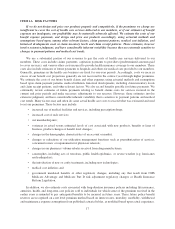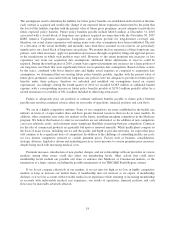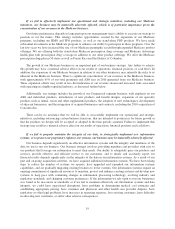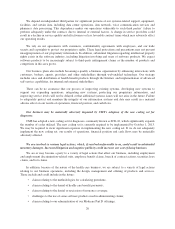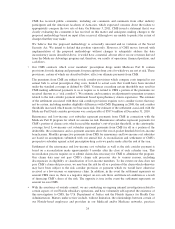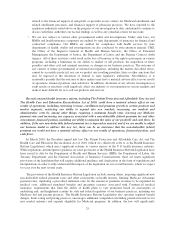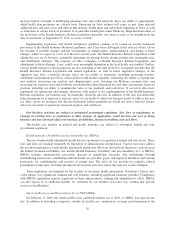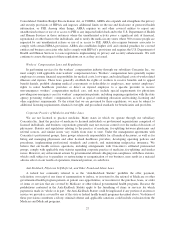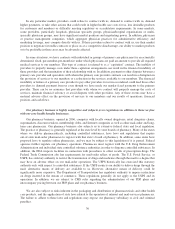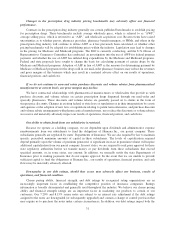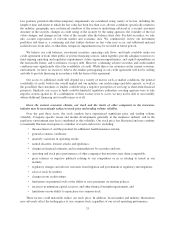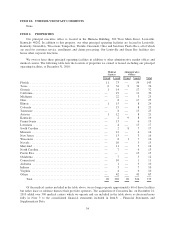Humana 2010 Annual Report Download - page 35
Download and view the complete annual report
Please find page 35 of the 2010 Humana annual report below. You can navigate through the pages in the report by either clicking on the pages listed below, or by using the keyword search tool below to find specific information within the annual report.related to the financial support of non-profit or provider access centers for Medicaid enrollment and
related enrollment processes, and financial support of physician practices. We have reported to the
regulatory authorities noted above on the progress of our investigation to date, and intend to continue to
discuss with these authorities our factual findings as well as any remedial actions we may take.
• We are also subject to various other governmental audits and investigations. Under state laws, our
HMOs and health insurance companies are audited by state departments of insurance for financial and
contractual compliance. Our HMOs are audited for compliance with health services by state
departments of health. Audits and investigations are also conducted by state attorneys general, CMS,
the Office of the Inspector General of Health and Human Services, the Office of Personnel
Management, the Department of Justice, the Department of Labor, and the Defense Contract Audit
Agency. All of these activities could result in the loss of licensure or the right to participate in various
programs, including a limitation on our ability to market or sell products, the imposition of fines,
penalties and other civil and criminal sanctions, or changes in our business practices. The outcome of
any current or future governmental or internal investigations, including the matters described above,
cannot be accurately predicted, nor can we predict any resulting penalties, fines or other sanctions that
may be imposed at the discretion of federal or state regulatory authorities. Nevertheless, it is
reasonably possible that the outcome of these matters may have a material adverse effect on our results
of operations, financial position, and cash flows. In addition, disclosure of any adverse investigation or
audit results or sanctions could negatively affect our industry or our reputation in various markets and
make it more difficult for us to sell our products and services.
Recently enacted health insurance reform, including The Patient Protection and Affordable Care Act and
The Health Care and Education Reconciliation Act of 2010, could have a material adverse effect on our
results of operations, including restricting revenue, enrollment and premium growth in certain products and
market segments, restricting our ability to expand into new markets, increasing our medical and
administrative costs by, among other things, requiring a minimum benefit ratio, lowering our Medicare
payment rates and increasing our expenses associated with a non-deductible federal premium tax and other
assessments; financial position, including our ability to maintain the value of our goodwill; and cash flows. In
addition, if the new non-deductible federal premium tax is imposed as enacted, and if we are unable to adjust
our business model to address this new tax, there can be no assurance that the non-deductible federal
premium tax would not have a material adverse effect on our results of operations, financial position, and
cash flows.
In March 2010, the President signed into law The Patient Protection and Affordable Care Act and The
Health Care and Education Reconciliation Act of 2010 (which we collectively refer to as the Health Insurance
Reform Legislation) which enact significant reforms to various aspects of the U.S. health insurance industry.
While regulations and interpretive guidance on some provisions of the Health Insurance Reform Legislation have
been issued to date by the Department of Health and Human Services (HHS), the Department of Labor, the
Treasury Department, and the National Association of Insurance Commissioners, there are many significant
provisions of the legislation that will require additional guidance and clarification in the form of regulations and
interpretations in order to fully understand the impacts of the legislation on our overall business, which we expect
to occur over the next several years.
The provisions of the Health Insurance Reform Legislation include, among others, imposing significant new
non-deductible federal premium taxes and other assessments on health insurers, limiting Medicare Advantage
payment rates, stipulating a prescribed minimum ratio for the amount of premium revenues to be expended on
medical costs, additional mandated benefits and guarantee issuance associated with Commercial medical
insurance, requirements that limit the ability of health plans to vary premiums based on assessments of
underlying risk, and heightened scrutiny by state and federal regulators of our business practices, including our
Medicare bid and pricing practices. The Health Insurance Reform Legislation also specifies required benefit
designs, limits rating and pricing practices, encourages additional competition (including potential incentives for
new market entrants) and expands eligibility for Medicaid programs. In addition, the law will significantly
25




